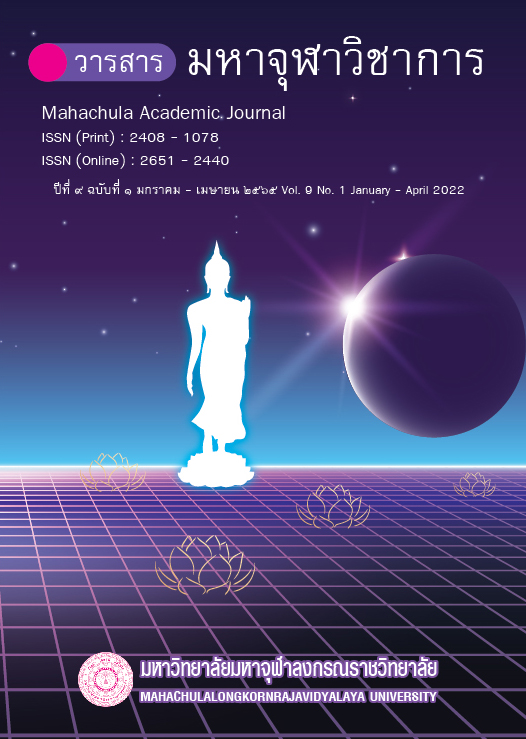The development of Community Reconciliation According to the Buddhist way in Samutsongkhram Province
Main Article Content
Abstract
This research on “The Development of Community Reconciliation according to the Buddhist Way in Samutsongkhram Province” aims to study the process of reconciliation building in Samut Songkhram province, to develop and create reconciliation according to the Buddhist way of life in the community of Samut Songkhram Province, and to propose a development policy to create reconciliation in the community according to the Buddhist way of Samut Songkhram Province.
The results of reconciliation development according to the Buddhist community way found that the practice guidelines of the people in the community was to use the five precepts as the basis for organizing behavior and using the sharing principle of sufficiency economy which is the way of living together with kindness, resulting in the reconciliation development which was consistent to people’s way of life in the community through Buddhist practices as the basis. Thus, it was easier to build behaviors in order to build reconciliation. In terms of policy proposal for the reconciliation development in the community according to the Buddhist thought shows that starting from family institutions, religious institutions, government institutions, educational institutions It has been accepted into the practice of Buddhist way to building reconciliation in the community, by with conducting religious, economic, and administrative activities causing the voluntary spirit to work together in a systematic way which was a way to access to make community reconciliation and sustainable development. In the aspect of community environment according to the Buddhist thought shows that maintaining both internal and external environment of the community relying on the administrative structure of the community such as the village headman, the sub-district headman, and the sub-district administrative organization, religious and educational institutions gathered to organize activities, which was to build good relationships with each other in the community and resulting to build unity strength, and unity community called reconciliation in the community. As for the community leadership of the reconciliation project according to the Buddhist thought, shows that the community leadership was to motivate people in the community to be socially responsible, and make sacrifices for the benefit of the community. This factor caused due to religious leaders applying Buddhist teachings for living together through Buddhist rituals and creating a role model for being a good community leader by applying Dhamma principles, namely the four Brahmavihara, four Sanghahavatthu, in order to create generosity among each other in the community. Finally, in terms of the behavior of living life of the community reconciliation project according to the Buddhist way shows that the community used the cooperation of Baan (home), Wat (Buddhist monastery) and Rongrean (School) (Bowon) as the guideline for practice. To be kind to each other causing dependence behavior which is a desirable behavior of people in the community to cause more love and unity.
Article Details

This work is licensed under a Creative Commons Attribution-NonCommercial-NoDerivatives 4.0 International License.
References
กฤษฎา แซ่หลี. “การสร้างความปรองดองสมานฉันท์ ด้วยการขับเคลื่อน โครงการหมู่บ้านรักษาศีล ๕ จังหวัดพระนครศรีอยุธยา”. ดุษฎีนิพนธ์. สาขาวิชารัฐประศาสนศาสตร์. คณะสังคมศาสตร์ : มหาวิทยาลัยมหาจุฬาลกรณราชวิทยาลัย, ๒๕๕๘.
ชัยวัฒน์ สถาอานันท์. อาวุธมีชีวิต: แนวคิดเชิงวิพากษ์ว่าด้วยความรุนแรง. กรุงเทพมหานคร : สำนักพิมพ์ฟ้าเดียวกัน, ๒๕๔๖.
พระธรรมโกศาจารย์ (พุทธทาสภิกขุ). พุทธศาสนากับคนรุ่นใหม่และสังคมไทยในอนาคต. กรุงเทพมหานคร : สำนักพิมพ์สุขภาพใจ, ๒๕๒๕.
มหาวิทยาลัยมหาจุฬาลงกรณราชวิทยาลัย.พระไตรปิฎกภาษาไทย ฉบับมหาจุฬาลงกรณราชวิทยาลัย เล่ม ๑๑, ๒๑, ๒๕. กรุงเทพมหานคร : โรงพิมพ์มหาจุฬาลงกรณราชวิทยาลัย, ๒๕๓๙.
สำนักงานพระพุทธศาสนาแห่งชาติ. คู่มือการดำเนินงานโครงการสร้างความปรองดองสมานฉันท์ โดยใช้หลักธรรมทางพระพุทธศาสนา “หมู่บ้านรักษาศีล ๕. กรุงเทพมหานคร : โรงพิมพ์สำนักงานพระพุทธศาสนาแห่งชาติ, ๒๕๕๗.
Kongjan, W. “The Model of Strengthening the Stability of the Family by Buddhist Integration”. Journal of MCU Peace Studies, 4 (Special 1), (2016): 257-269.
Atthakorn, W.. Roi Et hospital offices factors culminating in observing five precepts. Thematic paper Graduate School Mahamakut Buddhist University, 2014.


